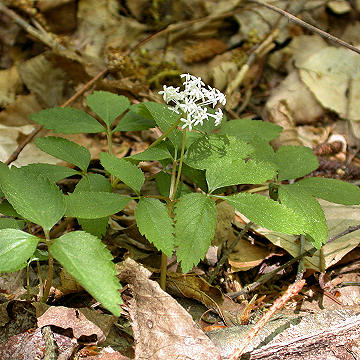

Panax trifolius - (image 1 of 4)
Taxonomy
Family: Araliaceae
Habitat
Rich woods and bottomlands. On hummocks in swampy woodlands.
Associates
Occurs with Mitchella repens on hummocks.
Distribution
Quebec and Nova Scotia west to MN, south to PA, IN, WI, MN, and in mountains to NC, TN, and GA. Absent from IL, though populations occur in southeast WI and northwest IN.
Morphology
Perennial herb from a small, round, tuberous root. Stems to 10-20 cm. Leaves palmately compound; leaflets 3-5, lanceolate to elliptic or oblanceolate, obtuse or somewhat acute, finely serrate, up to 8 cm long, sessile or subsessile at the base. Flowers white or pinkish, often unisexual, in rounded, umbelliform clusters on a solitary peduncle 2-8 cm long; styles typically 3. Fruit a small, yellowish, berry-like drupe.
Notes
Flowers June to July.
Wetland indicator: Facultative Upland
The small tubers are edible. Panax is Greek for "cure-all", given by Linnaeus for the reputation that some species were a panacea (see P. quinquefolius). The specific epithet is also spelled trifolium.
References
Gleason, Henry A. and A. Cronquist. 1991. Manual of Vascular Plants of Northeastern United States and Adjacent Canada. Second Ed.
The New York Botanical Garden. Bronx, NY
Peterson, L. A. 1977. A Field Guide to Edible Wild Plants: Eastern and central North America.
Houghton Mifflin Company. New York, NY
Swink, F. and G.
Wilhelm. 1994. Plants of the Chicago Region.
Indiana Academy of Science. The Morton Arboretum. Lisle, Illinois.
|
Michael Hough © 2009 |